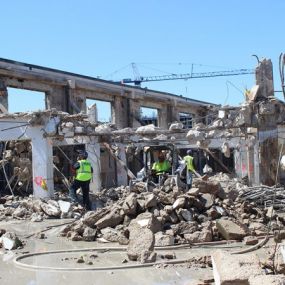After demolitions, Museum of the Bible starts to take shape for late 2017 launch

The Museum of the Bible is taking shape near the National Mall in Washington DC and is due to open in November 2017 perhaps reflecting the state of faith in the United States.
Nearly a year ago the eight-story, 430,000-square-foot (40,000 square meter) construction of the Museum of the Bible took a leap forward with a demolition at the site three blocks from the capitol.
Despite proximity to the center of power, this is no government institution that will make the Bible a tourist attraction.
HOBBY LOBBY BACKING
It's a private project led by the Green family which owns the Oklahoma-based craft chain, Hobby Lobby.
It will house artifacts from the family's impressive collection of biblical manuscripts, Torah scrolls, Dead Sea Scroll fragments, cuneiform texts dating from the time of Abraham, papyri and manuscripts, and rare printed Bibles.
The Green's collection is one of the largest private collections of such artifacts in the world, made up of about 40,000 objects, writes The Atlantic.
Many of them were surprisingly unknown to scholars and the general public before the Greens acquired them after they made their first purchase six years ago.
In early 2015 Museum of the Bible President Cary Summers announced that some of the biggest names in the museum and monuments' history will play as the project's lead partners for design and construction.
"We've empowered them with the task of creating a museum space that honors this site's history, improves the immediate area and neighborhood, and captures the essence of the Bible through a recognizable, iconic landmark," explained Summers.
Throughout 2015, visitors to the site have witnessed the ongoing demolition at the DC site.
Later, across 2016 and 2017, will come the installation of the new rooftop addition, expansion above the Washington Office Center, exterior glazing and renovations, streetscape improvements, and, of course, build-out of the museum's content and experiential technologies.
CIVIL CONTRACTORS
Clark Construction, ranked one of the most prominent building and civil contractors in the United States, will lead the construction efforts out of its Bethesda, Maryland.
Its recent work includes the White House Visitor Center renovation and the Smithsonian's National Museums of African American History and Culture, and of the American Indian.
Working with Clark is the museum's architectural design team, D.C.-based SmithGroupJJR, the 8th-largest U.S. architecture/engineering firm and the world's 36th-largest architecture practice.
Its portfolio includes the Smithsonian's National Museums of African American History and Culture, and of the American Indian, as well as the International Spy Museum.
Among the teams developing the museum's three central exhibit floors - focused on the Bible's impact, narrative and history – are:
• The PRD Group out of Chantilly, Virginia, which has also worked on the Smithsonian National Museum of American History and National Museum of Natural History. PRD is directing the History of the Bible floor.
• Oscar-nominated firm BRC Imagination Arts in Burbank, California, is developing the Narrative of the Bible floor. Its work includes such sites as the Abraham Lincoln Presidential Library and Museum, Disney's Hollywood Studio Orlando and Universal Studios Japan.
• Nashville-based Jonathan Martin Creative will create a first-century Nazareth village replica.
• C&G Partners in New York is leading design of the Impact of the Bible floor. It has led past design efforts for the U.S. Holocaust Memorial Museum, the Metropolitan Museum of Art and the Museum of Jewish Heritage.
Such a mission certainly needs powerful backers and Hobby Lobby which has a yearly revenue of some $3.7 billion according to Forbes, is just such a group.
GREEN FAMILY'S BIBLE PROMOTION
The Greens do a lot of work promoting the Bible including the creation of films with biblical themes, owning a chain of Christian bookstores, supporting the development of a Bible curriculum for schools, sponsoring trips to Israel and donating to Christian charities.
The Atlantic cites their spending $70 million once to prop up Oral Roberts University at a difficult time and notes that as president of Hobby Lobby Steve Green devotes half his time to the museum.
At a time when the antiquities trade is under close international scrutiny, the Greens' rapidly acquired private collections has certainly raised many questions about its provenance.
Green tells The Atlantic, "We aren't collectors, we're storytellers."

He says the museum does not aim to serve any particular section of believers.
"We exist to invite all people to engage with the Bible.
"We invite biblical exploration through museum exhibits and scholarly pursuits."
In its first nonprofit filing, in 2010, the said its primary purpose was "to bring to life the living word of God, to tell its compelling story of preservation, and to inspire confidence in the absolute authority and reliability of the Bible."
